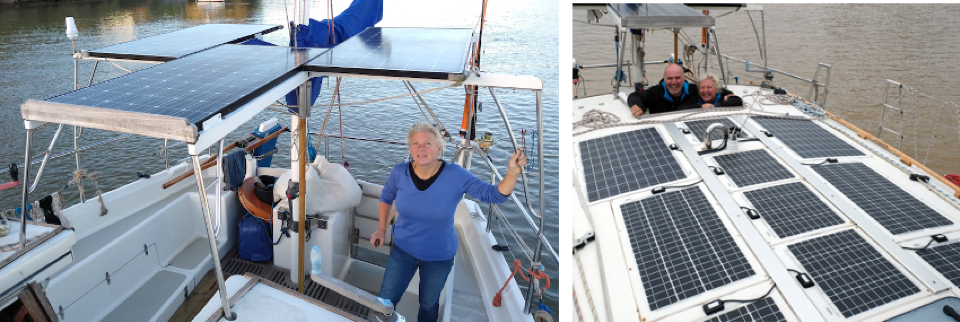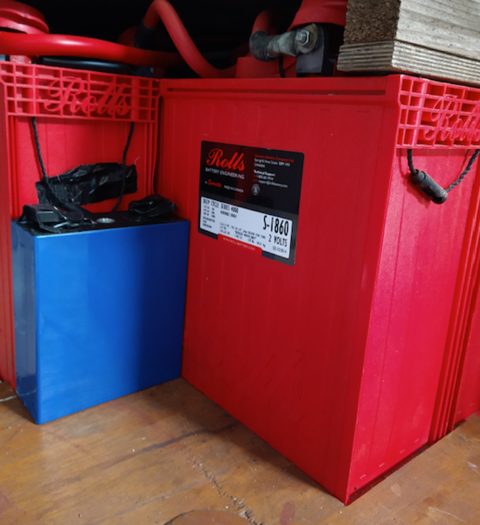In the last blogs on ‘use only what you need’, on the basics of fossilfree sailing, on cooking, sailing, and on the human factor, we showed how we use only what we need, and how you can do that. It saves about 70 or 80%. Yes, that much! So, we use only little.
Now that the consumption is so little, we can generate our own energy. On our ship we use the three general ways to generate it: solar, wind and hydro energy. This ‘tripod’ gives us the stable energy input we need to stay in balance. Check our Energy Balance, our basis on board. We have never had a shortage. Although it was sometimes not much.
All devices are quality stuff, but not fancy; it is all just ‘from the shelf’.
You can do the same.

Solar panels
Instead of a canvas bimini top, we made a fixed one and covered it with solar panels. In the 4 or 5 hours that the sun shines well in a cloudless sky, they deliver about 30% of their rated peak energy, and when it is cold, they can do 40%. This is pretty good. These ones are thin, so the wind can keep them cool, which is the prerequisite for an effective working solar panel.
The deck panels are mounted on the deck, which is also insulated. So, in the tropics these ones work badly, in the subtropics reasonably. In the higher latitudes, they stay cool and they do just as well as the panels on the bimini top.
Behind the windows we put some flexible panels. Flexible panels deliver relatively poor, But, they do better than expected, because they get the solar radiation also from the reflecting water. That counts double.

All details and numbers you find here including their contribution to our Energy Balance
Wind turbine
Any wind turbine works only with enough wind. There is one place where there is most wind, and that is high, in an undisturbed area. Our windmill is put on the mizzen mast, on 7 meters high. It should at least be over 5 meters, do no spend money on a windmill put on a pole of 3 or 4 meters.
Most efficient is a three-blade turbine. All A-brands have these mills.
We chose for the Silentwind, because it combines a light weight with a high yield. The MPPT (the converter box, with the vulnerable electronics) is not in the turbine but you can put it in a dry area. The device has a ‘light wind booster’ in it, so even in light winds it can take some energy out of it.

All details and numbers you find here including their contribution to our Energy Balance. An article comparing three windturbines, you find here.
Hydro generation: Autoprops and alternators
We use the most efficient Autoprops https://www.bruntonspropellers.com/autoprop/ as propellers. They are connected to E-tech www.etechdrives.com electric motors. They give us propulsion. But if the sails give us the speed, we switch a button to ‘Charge’ and the motors turn into alternators. The Autoprops will rotate in the water (like the windmill in the wind) and will run the alternators, making the energy to put in the battery bank.

All details and numbers you find here, including their contribution to our Energy Balance.
Battery bank
The Ya has had a conventional battery bank. It could contain 55 kWh (kiloWatthour). That is what an average Euopean family uses per week. After 7 years the bank was worn out. The energy content had reduced to only 30 kWh. Still this was enough, because we only just use what we need. But it was time to renew them.
We renewed them for a Lithium Ferro Phospate bank, or LFP. These are like the light and modern batteries used in electric cars, but then then in a safe, not inflammable version. The batteries are better controlled than lead acid ones, they last two times longer and the maintenance is nothing more then plugging it in a 220Volt outlet every three months.

The energy content is 42 kWh nominal, so 33 kWh effectively. In the 4 months of use it has never been empty because of 4 reasons:
- the properties of the batteries are more efficient
- We only use what we need
- We only use what we need
- We only use what we need
In all comfort and pleasure!
